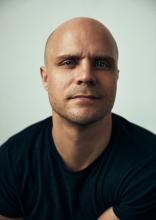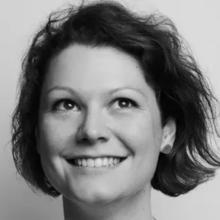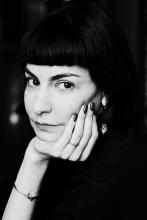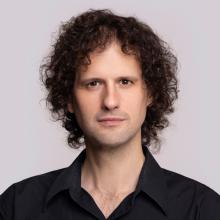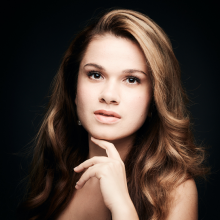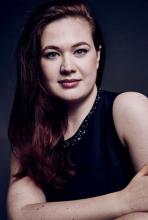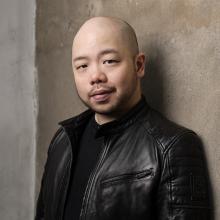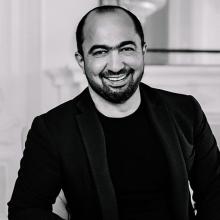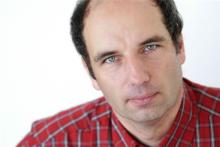Boris Godunov

Performance information
Voorstellingsinformatie
Performance information
Boris Godunov
Modest Mussorgsky (1839-1881)
Duration
3 hours and 30 minutes, incl. one interval
This performance is sung in Russian, supplemented with spoken texts in English. The performance is surtitled in Dutch (based on the translation by Gretske de Haan) and in English (translated by Michael Blass).
Opera in four acts with a prologue
Libretto
Based on the play Boris Godunov by Alexander Pushkin (1831) and History of the Russian State by historian Nikolai Karamzin (1818).
World premiere
27 January 1874
Mariinsky Theatre, St. Petersburg
Musical direction
Vasily Petrenko
Stage direction, set and costume design
Kirill Serebrennikov
Co-director and choreographer
Evgeny Kulagin
Co-set designer
Olga Pavliuk
Co-costume designer
Tatiana Dolmatovskaya
Lighting designer
Sergey Kucher
Video designer
Yurii Karikh
Dramaturgy
Daniil Orlov
Boris Godunov
Tomasz Konieczny
Feodor
David van Laar
Xenia
Inna Demenkova
Nurse
Polly Leech
Prince Vassily Ivanovich Shuisky
Ya-Chung Huang
Andrei Shchelkalov
Jasurbek Khaydarov*
Pimen
Vitalij Kowaljow
Grigori Otrepjev
Dumitru Mîțu
Marina Mnishek
Raehann Bryce-Davis
Rangoni
Gevorg Hakobyan
Varlaam / Mitiukha
Shen Yang
Missail / Boyar
Steven van der Linden*
The Hostess of the Inn
Eva Kroon
Yurodivy ('A Simple Man')
Odin Lund Biron
Nikitich
Roger Smeets
* Dutch National Opera Studio
Royal Concertgebouw Orchestra
Chorus of Dutch National Opera
Chorus master Edward Ananian-Cooper
Nieuw Amsterdams Children’s Chorus (part of Nieuw Vocaal Amsterdam)
Chorus master Pia Pleijsier
Co-production with Grand Théâtre de Genève
Production team
Assistant-conductor
Aldert Vermeulen
Junior assistant-conductor
Alejandro Cantalapiedra
Assistant-director during performances
Meisje Barbara Hummel
Intern directing
Iris Skolidi
Assistant-choreographer
Ivan Estegneev
Intimacy coordinators
Zarah Bracht
Markoesa Hamer
Maarten van Grootel (trainee)
Répétiteurs
Jan-Paul Grijpink
Liuba Orfenova
Language coach
Liuba Orfenova
Assistant-chorusmaster
Irina Sisoyeva
Language coach chorus
Irina Sisoyeva
Stage managers
Marie-José Litjens
Marjolein Bergsma
Pieter Heebink
Paul Hoekman (intern)
Artistic planning
Emma Becker
Assistant set design
Eugen Friesen
Assistant costume design
Alexandra Kharina
Costume supervisor
Maarten van Mulken
Interpreter
Varja Klosse
Master carpenter
Jeroen Jaspers
Lighting manager
Coen van der Hoeven
Props crewmen
Peter Paul Oort
Senior dresser
Jenny Henger
Senior make-up artists
Linda Vreeburg
Sasja Brasser
Sound engineer
Juan Verdaguer
Dramaturge
Laura Roling
Surtitles director
Eveline Karssen
Surtitles operator
Irina Trajkovska
Senior music librarian
Rudolf Weges
Orchestra inspector
Peter Tollenaar
Harriët van Uden
Production coordinator
Gerko Min
Valerie Smalen
Production manager
Emiel Rietvelt
Extras
Dick Addens
Thespis Athineus
Creso Filho
Rowan Kievits
Yael Le Roy
Paula Melgers
Alexey Shkolnik
Royal Concertgebouw Orchestra
First violin
Hebe Mensinga (concertmaster)
Ursula Schoch
Marleen Asberg
Tomoko Kurita
Borika van den Booren-Bayon
Marc Daniel van Biemen
Mirte de Kok
Gemma Lee
Mirelys Morgan Verdecia
Junko Naito
Benjamin Peled
Nienke van Rijn
Jelena Ristic
Michael Waterman
Katharina Von Behren
Lonneke van Straalen
Second violin
Caroline Strumphler
Marlene Dijkstra
Elise Besemer van den Burg
Leonie Bot
Nadia Ettinger
Coraline Groen
Sanne Hunfeld
Sjaan Oomen
Jane Piper
Eke van Spiegel
Anna de Veij Mestdagh
Joanna Westers
Sam Panner
Ilka van der Plas
Valerie Schweighofer
Viola
Santa Vižine
Saeko Oguma
rederik Boits
Roland Krämer
Guus Jeukendrup
Jeroen Quint
Eva Smit
Martina Forni
Yoko Kanamaru
Vilém Kijonka
Edith van Moergastel
Jeroen Woudstra
Cello
Gregor Horsch
Joris van den Berg
Chris van Balen
Jérôme Fruchart
Christian Hacker
Maartje-Maria den Herder
Izak Hudnik Zajec
Yong-Jun Lee
Boris Nedialkov
Honorine Schaeffer
Double bass
Dominic Seldis
Théotime Voisin
Rob Dirksen
Léo Genet
Felix Lashmar
Georgina Poad
Flute
Emily Beynon
Julie Moulin
Piccolo
Vincent Cortvrint
Oboe
Alexei Ogrintchouk
Miriam Pastor Burgos
Clarinet
Olivier Patey
Hein Wiedijk
Bassoon
Andrea Cellacchi
Helma van den Brink
Horn
Katy Woolley
Fons Verspaandonk
Jaap van der Vliet
Liz Chell
Trumpet
Omar Tomasoni
Jacco Groenendijk
Trombone
Jörgen van Rijen
Nico Schippers
Martin Schippers
Tuba
Perry Hoogendijk
Timpani
Tomohiro Ando
Chorus of Dutch National Opera
Sopranos
Aliya Akhmadeeva, Diana Axentii, Lisette Bolle, Else-Linde Buitenhuis, Jeanneke van Buul, Caroline Cartens, Antonia Dunjko, Nicole Fiselier, Melanie Greve, Deasy Hartanto, Maaike Hupperetz, Simone van Lieshout, Tomoko Makuuch,i Vesna Miletic, Sara Pegoraro, Elizabeth Poz, Jannelieke Schmidt, Sandra Siniväli, Kiyoko Tachikawa, Imara Thomas, Varvara Tishina
Altos
Marion van den Akker, Irmgard von Asmuth, Elsa Barthas, Anneleen Bijnen, Daniella Buijck, Rut Codina Palacio, Johanna Dur, Valerie Friesen, Yvonne Kok, Fang Fang Kong, Maria Kowan, Myra Kroese, Itzel Medecigo, Maaike Molenaar, Emma Nelson, Sophia Patsi, Marieke Reuten, Klarijn Verkaart, Ruth Willemse
Tenors
Gabriele Bonfanti, Thomas de Bruijn, Wim-Jan van Deuveren, Pim van Drunen, Frank Engel, Milan Faas, Ruud Fiselier, Cato Fordham, Livio Gabrielli, Dimo Georgiev, John van Halteren, Erik Janse, Robert Kops, Raimonds Linajs, Roy Mahendratha, Tigran Matinyan, Simion Novac, Richard Prada, Andrew Rawlings Carbo, Eric Reddet, Mirco Schmidt, Raymond Sepe, François Soons, Julien Traniello, Jeroen de Vaal, Bert Visser, Rudi de Vries
Basses Ronald Aijtink, Peter Arink, Alfonso Michele Ciulla, Nicolas Clemens, Jeroen van Glabbeek, Julian Hartman, Agris Hartmanis, Hans Pieter Herman, Sander Heutinck ,Tom Jansen, Geert van der Kaaij, Dominic Kraemer, Richard Meijer, Matthijs Mesdag, Maksym Nazarenko, Gulian van Nierop, Tobias Odenwald, Christiaan Peters, Hans Pootjes, Matthijs Schelvis, Jaap Sletterink, Vincent Spoeltman, René Steur, Berend Stumphius, Harry Teeuwen, Rob Wanders, Marijn Zwitserlood
Nieuw Amsterdams Children’s Chorus
Paula Cabrera Pons, Noor Denekamp, Leopold Enzler, Teresa García Dueñaz, Sophia Habashi, Vera Hardeveld Kleuver, Lore Hilbrands, Olivia Hogewind, Mara Jacobs, Helena Jeremiasse, Amélie Kanter, Calla Kemper, Lena Koedam, Isadora Koekoek, Elodie Koene, Alide Koop, Ramona Koops, Glascha Lagrande, Hadassah legesse, Adiam Misgna, Ela Mutlu, Lidewij Nieuwenhuizen, Alessia Noginova, Adriano Oikonomou, Thalia Oyewole, Sasha Pattberg, Eva Pavlova, Yves Peters, Alma Roelofsen, Rhinja Simons, Zélie Wyers, Fee Zonneveld, Sophia van Zuijlen

In a nutshell
On the composer, the historical drama, the stage director and photographer Dmitry Markov.
In a nutshell
The composer
Modest Mussorgsky (1839–1881) was a largely selftaught Russian composer and a member of “The Mighty Handful” – a group of five composers who sought to develop an authentic Russian musical style, independent of Western influences. His first and only completed opera is Boris Godunov. The original 1869 version was rejected by the theatre management, who felt that the opera, dominated by male voices, lacked a “feminine element.” Mussorgsky took this rejection as an opportunity to thoroughly revise his work. He added a new act centered on the Polish character Marina Mniszek and made significant changes to the opera’s dramaturgical structure and balance. In this 2025 production in Amsterdam, the 1872 version is performed, with the St Basil scene from the 1869 version inserted.
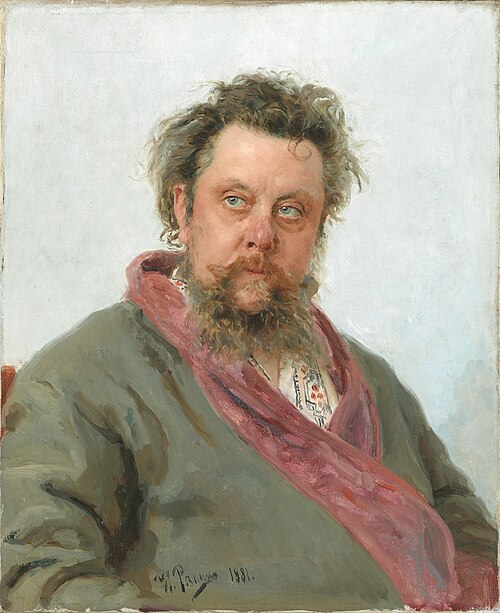
The lens of history
Historical drama experienced a strong surge in Russia after Nikolai Karamzin (1766–1826) made a wealth of historical material available with his monumental History of the Russian State. Around the time of the Emancipation – the abolition of serfdom in 1861 – reflecting on the past was considered an intellectual obligation. Historiography and historical drama functioned as tools to examine and question current political and social ideas. Boris Godunov, based on Alexander Pushkin’s 1831 play of the same name, exemplifies this approach. The opera not only depicts the downfall of a ruler tormented by guilt but also offers a critical portrait of the Russian people’s relationship to political power.

Stage direction
Kirill Serebrennikov places Boris Godunov firmly in Russia in the near future. His stage direction focuses on the people: he shows how the daily lives of ordinary citizens are shaped by political realities. Onstage, a cross-section of a panelka apartment block appears – the kind of prefabricated housing built on a large scale during the Soviet era. In each apartment, a television screen displays carefully curated propaganda. In this production, the Yurodivy (translated in this production as “a simple man”), becomes someone who has returned home after being convicted in a political trial. Drawing on a wide range of “last words” from defendants in contemporary Russian trials – from activists to artists and teenagers – Serebrennikov composed additional spoken texts for this character.

Dmitry Markov
For the set design, Serebrennikov drew inspiration from the work of Russian photographer Dmitry Markov (1982–2024). Using his smartphone, Markov documented everyday life in Russia’s provinces and outskirts. He shared his photos on Instagram, where he had been active since 2012. One of his principles was to post photos online only on the day they were taken, staying close to current reality. Working within the platform’s limitations – for a long time, Instagram allowed only square images – Markov developed a distinctive visual signature. Even when his lens captured poverty, sorrow, or pain, his gaze conveyed empathy and humanity. “He was able to capture the soul of the people, their DNA. If you want to understand Russians, you need to look at his photos,” says Serebrennikov.

The story
The Russian people are urged to implore Boris Godunov to stay in power and accept the throne. A day of national celebration arrives. Boris Godunov has chosen to remain in power to preserve the country’s stability. The people praise their tsar and rejoice ...
The story
Prologue
The Russian people are urged to implore Boris Godunov to stay in power and accept the throne.
A day of national celebration arrives. Boris Godunov has chosen to remain in power to preserve the country’s stability. The people praise their tsar and rejoice.
First Act
The life of ordinary people
The elderly Pimen is writing a history of Russia. He is visited by Grigory, who confides in him about the nightmares that haunt him. In response, Pimen recounts stories of former rulers, including the tale of the murder of Tsarevich Dmitry — an event that cleared the way for Boris Godunov’s rise to power.
Shaken yet exhilarated, Grigory leaves Pimen and falls in with two wandering drunkards, Varlaam and Missail, who are pestering the Hostess for more to drink. She warns Grigory that the authorities are looking for a fugitive and that the police have become increasingly ruthless. Just then, patrolmen arrive. Grigory manages to slip away.
Second Act
The ruled and the rulers
Xenia mourns the death of her fiancé with unrelenting grief. Her younger brother Fyodor tries in vain to comfort her. Only the presence of Tsar Boris brings her some peace. But Boris himself is deeply troubled — all around him he sees ruin, betrayal, and denunciation. Worse still, Prince Vasily Shuisky arrives with grim news: a man claiming to be Tsarevich Dmitry is laying claim to the throne. The very mention of Dmitry sends Boris into a steep mental decline.
Third Act
Intermedio
Marina Mnishek, a proud and ambitious noblewoman, dreams of ruling Russia. She has no interest in romance; talk of suitors falling at her feet only bores her. The scheming courtier Rangoni spins a web of intrigue: Marina must form a romantic alliance with the Pretender — the False Dmitry — and together they will seize the Russian throne. Marina cannot resist Rangoni’s persuasion and agrees to play along. Surrounded by allies and advisors, she celebrates the coming downfall of Boris — and her own rise to power.
The Pretender, however, trembles with love for Marina. She means more to him than the throne.
Fourth Act
The Time of Troubles
Boris continues to rule, while the people endure a life of strife, toil, and deprivation. A group of children mocks the Simple Man, who scolds them — but then hears a rising chorus of voices crying out for help, and for bread. Their plea swells into a demand. In the crowd, the Simple Man sees Boris himself.
Prince Shuisky tells his subordinates that he has recently seen the tsar — and that Boris’s mental state is a cause for grave concern. As if to confirm his words, Boris appears and begins to ramble incoherently. Shuisky summons Pimen, supposedly to soothe Boris. But Pimen’s tale of the murdered Tsarevich Dmitry delivers the final blow: Boris’s illness overwhelms him, and after prolonged mental and physical torment, he dies.
With Boris’s death, the Time of Troubles descends in full. The Simple Man foresees the catastrophe to come — and weeps for Russia’s fate.

Timeline
From Tsar Ivan the Terrible - who dies after a long reign of terror in 1584 - to the 1872 revised version of Boris Godunov at Dutch National Opera in 2025.
Timeline
1584
Ivan the Terrible dies after a long reign of terror. He is succeeded by his mentally deficient son Feodor. Because Feodor is deemed not fit to rule, Boris Godunov, Feodor's brother-in-law, is appointed regent.
1591
Feodor’s younger half-brother Dimitri, who has been banished to Uglich along with his mother, dies of an epileptic fit. His family claim he was murdered.
1598
The death of Feodor marks the end of the centuries-old Rurik dynasty; there is no successor to the throne. After intensive lobbying and manipulation of an impressionable populace, Boris Godunov is proclaimed the new tsar by the zemski sobor, the Assembly of the Land.

1601
A long period with a colder climate is causing problems for Russia. A sequence of natural disasters leads to failed harvests and famine. The farmers hold the tsar responsible. Amid this social unrest, someone appears in Poland claiming to be the tsarevich Dimitri (who is dead). This ‘false Dimitri’ receives support from the Polish nobility and from some Russian boyars opposed to Boris, such as the Romanovs.
1605
Boris Godunov dies, leading to the start of the Time of Troubles (1605-1613), a period of civil war that only ends when Michael Romanov is made tsar in 1613. The Romanov dynasty would rule Russia until the outbreak of the Russian Revolution in 1917.
1818
Nikolai Karamzin (1766-1826) publishes his wide-ranging History of the Russian State (1818), the first comprehensive history of the country. It accuses Boris Godunov of murdering the real tsarevich Dimitri. This version of events was propagated by Boris Godunov’s opponents, including the Romanovs.
1831
Aleksandr Pushkin (1799-1837) writes his historical tragedy Boris Godunov. He paints Boris as a just tsar but with a crime weighing on his conscience. Boris is destroyed by his own sense of guilt. The play is ambiguous about what actually happened. The character of the pretender to the throne, the false Dimitri, is a brilliant creation by Pushkin — a chameleon able to adapt to whatever situation he finds himself in.
1839
Modest Petrovich Mussorgsky is born in Karevo. At first, his only music education consists of some piano lessons.
1856
While serving in a regiment of the guard in Saint Petersburg (1856-58), Mussorgsky starts composing music. He meets Mili Balakirev, who teaches him the rudiments of music theory. Together with Balakirev, César Cui, Aleksander Borodin and Nikolai Rimsky-Korsakov, Mussorgsky forms a group of composers known as the Mighty Handful or The Five, who cultivate a Russian style of music uncorrupted by Western influences.

1861
Serfdom persists in Russia until deep into the nineteenth century. Landowners have almost complete control over the lives of the serfs who work on their farms and are tied to that land. The practice of serfdom is eventually abolished on 3 March 1861. The legacy of this centuries-old custom is felt even today in modern Russia.
The emancipation of the serfs constitutes a significant financial setback for Mussorgsky, who has been living off the income from his family’s estate (generated by the serfs working there). He develops a severe alcohol addiction.
1869
Mussorgsky completes the first version of his opera Boris Godunov. It is rejected by the management of the Imperial Theatres in Saint Petersburg because the opera lacks a ‘female element’.
1872
Mussorgsky completes the second, definitive version of Boris Godunov with a new ‘Polish act’ and several new scenes. The opera is first performed in 1874.
1881
Mussorgsky has a serious alcohol problem. On 24 February 1881, he suffers three consecutive alcohol-induced epileptic fits. His friends take him to a hospital, where his health recovers briefly. It is at this point that one of Russia’s leading artists, Ilya Repin, paints a famous portrait of the composer. However, Mussorgsky’s health has been damaged irrevocably and he dies less than one month later, shortly after his forty-second birthday. Rimsky-Korsakov takes charge of his musical legacy. In music history, Mussorgsky has had a name for being a rough diamond who lacked finesse, needing someone else to make the necessary improvements. For a long time, his compositions were only heard in orchestrations written by others.
1908
The piano score of Rimsky-Korsakov’s second, definitive Boris adaptation is published and becomes the basis for the first performances of the opera outside Russia. This is the version in which the work has its international breakthrough. In 1940, Dmitri Shostakovich composes his own orchestration of the opera.
1977
The opera is performed in Mussorgsky’s original orchestration for the first time, with Jerzy Semkow conducting the Polish National Radio Symphony Orchestra.
2025
The piano score of Rimsky-Korsakov’s second, definitive Boris adaptation is published and becomes the basis for the first performances of the opera outside Russia. This is the version in which the work has its international breakthrough. In 1940, Dmitri Shostakovich composes his own orchestration of the opera.

An interview with Kirill Serebrennikov
In the lead-up to the rehearsal process of Boris Godunov, Olga Surkova—journalist, film scholar, and close collaborator of the Russian film legend Andrei Tarkovsky (1932–1986)—had an extensive conversation with Kirill Serebrennikov about the opera.
An interview with Kirill Serebrennikov
In the lead-up to the rehearsal process of Boris Godunov, Olga Surkova—journalist, film scholar, and close collaborator of the Russian film legend Andrei Tarkovsky (1932–1986)—had an extensive conversation with Kirill Serebrennikov about the opera.
Text: Olga Surkova
Olga Surkova: “Kirill, I’m eagerly awaiting your Boris Godunov — considered by many the greatest Russian opera. I was fortunate to attend the 1983 premiere, directed by Andrei Tarkovsky at Covent Garden, and wrote about it for the Dutch newspaper Volkskrant. That was a different era, with its own challenges. At the time, classical opera was only just beginning to modernize — cautiously. Yet even the liberties Tarkovsky took, without altering the historical setting, raised doubts among some critics…”
Kirill Serebrennikov: “Today, of course, the world of opera is entirely different. For me, the composer of the opera I’m staging is my co-author. We create the production together — he is one of us. That sense of co-authorship with truly great composers is vital to my work. No matter how talented a director or designer may be, he must abandon the urge to look up at the classics from below. Otherwise, he’ll be paralyzed by fear of an unattainable ideal, by the idol — and in this case, there are two: the composer Mussorgsky and the poet Pushkin, whose play forms the basis of the libretto.”
“Boris Godunov, the play, was written by Alexander Pushkin in 1825. Mussorgsky began work on the opera more than forty years later, in 1868 — after the formal abolition of serfdom in Russia in 1861, which was essentially slavery. Slavery that, in reality, continues to this day, merely in different forms.”
“In Boris Godunov, Pushkin followed the structure of Shakespearean drama. He was captivated by Shakespeare’s dramaturgy and sought to recreate his historical chronicles of power on Russian soil. For both Shakespeare and Pushkin, power is a panopticon of villains and a cascade of monstrous crimes. Power is sinful and guilty in all its deeds, and the blood it spills seeps into the earth — soil made fertile by futile sacrifice.”
“Pushkin’s Boris ascends the throne — as the people believe — by murdering the rightful heir. His wounded conscience, stained with a child’s blood, denies him true happiness or peace, leaving him unable to fulfill the vision he once had for his reign.”
“During the Time of Troubles, power hung from the tree of history like an overripe, rotting apple. Anyone — any chance figure — could pluck it. And so, in a clash of forces, two men converge, drawn by the same burning desire for supreme power. Boris claims the throne through murder; Grigory Otrepyev — a man from the lower ranks — declares himself a pretender, blindly driven by the tide of history. The cynical calculation against belief in random possibility. In the end, neither triumphs. Both are swallowed by the swamps of Russian ambiguity.”

Olga Surkova: “Was staging Boris Godunov at DNO your idea, or did the theatre propose it?”
Kirill Serebrennikov: “As a rule, in large opera houses, the administration itself creates the future repertoire of the theater and then offers the director the opportunity to stage a particular production if it interests him. But Boris Godunov is the first — and so far the only — case where I proposed it myself. Sophie de Lint asked what I most wanted to do, and I told her I had long dreamed of staging Mussorgsky’s Boris Godunov. She said they hadn’t done it for some time — and that’s how the project was born. After working on Der Freischütz and collaborating with the extraordinary Amsterdam chorus, I was even more certain I’d made the right choice.”
Olga Surkova: “I remember how freely, elegantly, and with such humor you reimagined Weber’s Der Freischütz in Amsterdam in 2022! The Dutch audience loved it. Now you offer them Boris Godunov — an epic, deeply philosophical, historical work with a far more tragic tone…”
Kirill Serebrennikov: “This opera has always been on my personal list of works I had to stage. I feel that its plot touches something fundamental in the Russian matrix. Russia has always lived — and continues to live — by its own set of rules, hard to explain from within and almost impossible to grasp from outside. I now find myself in a unique position: I know Russia from within, but after spending the last three years outside the country, I can also see it from the outside.”
“My Boris Godunov unfolds in a Soviet-era concrete apartment block, somewhere in the impoverished Russian provinces — a typical panel building. All sorts of people live there — the narod. In every room of every apartment, there’s a television. Through it, the authorities broadcast everything happening in the country. Everyone watches the same thing: about greatness, the lives of tsars, how life is getting better and richer. They watch passively, waiting to see which tsar will be replaced by another. The wheel of existence — endlessly turning.”
“Pushkin’s play ends with a line that mesmerizes me: “The people are speechless.” There is silence at the crossroads of history. The people are asked: “Why don’t you rejoice at the new tsar?” And they answer with deathly silence. How to interpret that silence? Does it mean rejection — a form of protest? Or does it reflect apathy, paralysis, exhaustion — silent submission? The meanings vary, but the silence remains a powerful symbol of the Russian paradox.”
“Mussorgsky offered his own version: in his opera, the people don’t stay silent. They tear down the fragile state structure and cast it to the winds. The Time of Troubles erupts into revolt — not revolution, but riot: senseless and merciless. It’s a very Russian rebellion, senseless and pitiless.”
“Through his music, Mussorgsky conveys — even more precisely than Pushkin’s words — what the Russian people are living through. Even today. For him, the people, not Boris with his tormented conscience, are the true protagonists. It is the people who drive the action and inspire Mussorgsky’s powerful, hypnotic, Shakespearean music.”
“As someone shaped by Russian culture, I was taught to love and pity the people. All the great Russian writers did — with awe and compassion. One was Nikolai Nekrasov, whose long poem Who Is Happy in Russia? I staged years ago at the Gogol Center. Nekrasov showed that, even after the abolition of serfdom, village life remained horrific. Nothing really changed. The instinct for servitude proved stronger than the will for freedom.”
“In Tarkovsky’s time — you mentioned his Godunov earlier — the Soviet people raised their hands in unanimous support for whatever the government said, without even listening. Any dissenters — “holy fools” — were removed, imprisoned, or exiled.”

“In Putin’s Russia, people remain speechless out of self-preservation — or swear loyalty to the regime. The state literally buys loyalty, offering the poorest villagers money to go to war and kill neighbors — sums they never imagined before. There is no resistance. Those who protested are now imprisoned or exiled. But what’s wrong with people who send loved ones to war for a paycheck? Why do the widows thank the state instead of cursing it? How did we get here — where complaints are about rusty rifles or bad food, not the killing of innocents?”
“This war has deeply sobered me. It has opened my eyes. For many, it’s a moment of truth. That’s why, now more than ever, I feel compelled to stage Boris Godunov.”
Olga Surkova: “It seems no one before you has brought Godunov so close to today’s grim newborn reality — to the unsettling present of provincial Russia that seems to remain unchanged. That world is so vividly captured in the work of the remarkable photographer Dmitry Markov, whose images you incorporated into the staging. You collaborated with him, helped bring attention to his work — and it’s heartbreaking that he left this world so suddenly, on the same day as Navalny, no less.”
Kirill Serebrennikov: “Yes, it was devastating. Dima Markov was a friend — someone I felt deeply connected to. We didn’t see each other often, but we did a major exhibition of his work at the Gogol Center, had long conversations, and recorded one of our public dialogues. I helped him publish his first book.”
“He was extraordinary — soulful and incredibly fragile. From the start, he warned me: “I’m a real addict. Don’t get involved with me.” But I told him I would anyway. I kept offering help: “Dima, let’s get you into treatment, find good doctors.” But he’d been through rehab a hundred times. He said it was beyond fixing.”
“And maybe, precisely because of that fragility, Dima was able to dissolve completely into the Russian reality he photographed — to the point where people stopped noticing him. He’d arrive in some provincial town with just his phone, go to a market or military unit, and people would accept him as one of their own. That allowed him to take truly unique, intimate photographs.”
“His work had such authenticity and intimacy that it seemed as if people posed for him. But it was his skill — capturing that fleeting moment of absolute beauty. Like Cartier-Bresson: what seems like a casual snapshot becomes art.”
“Dima showed unvarnished Russia with love, compassion, and a tender inner light. His portrait of the people was honest, never flattering — but always loving. That’s why I invited him onto this project. He was deeply inspired and planned to shoot new photos specifically for Godunov. But he didn’t make it in time… Literally the day before he died, we were messaging about the production. Then, suddenly, he was gone.”
“It felt like a double nightmare — his death came on the same day as Alexei Navalny’s, February 16, 2024. One died in a Russian prison in Yamalo-Nenets, the other in Pskov. With Navalny, a fragile hope for change died. And with Dima, the country lost a remarkable artist — someone who saw it as no one else could.”
“I want to dedicate this opera in Amsterdam to Dima’s memory. That means a great deal to me.”

The creation of Boris Godunov
The composition of Boris Godunov proceeded in two stages. Mussorgsky completed the first version in 1869, the second in 1872.
The music of Boris Godunov
Boris Godunov was composed in two stages: Mussorgsky completed the first version in 1869 and the second in 1872. In the first version, he adopted the same operatic aesthetic he had explored in his previous project, The Marriage, namely of setting a play to music directly without first turning it into a libretto and with as few traditional opera elements as possible. The theatrical qualities of the second version are much stronger, with a better balance, as he managed to combine his realism with the dramatic principles of established opera tradition.
Text: Francis Maes
Mussorgsky found a wealth of characters and situations in Pushkin’s play Boris Godunov. It contains characters from all ranks of society, from the tsar to the illiterate policeman, and from the patriarch to the drunken, peripatetic monk. The two scenes that Mussorgsky took directly from Pushkin’s play – the monastic cell and inn scenes – offered numerous possibilities for the composer’s realism.
The music in the cell scene is imbued with a sacred monastic calm. The old monk Pimen is portrayed with a lofty singing style reminiscent of the emotional and eloquent tone used for recitals of Russian poetry. The gently twisting and turning parts in the orchestra reflect Pimen’s detached concentration as he writes his chronicle.
The inn scene is completely different. The two scruffy itinerant monks, Varlaam and Missail, and the imbecile policeman are a sharp contrast to the dignified Pimen, and the musical declamation of their prose texts is closer to ordinary speech. The whole scene is a tour de force of musical realism. Take the conversation between Grigori and the Hostess, for example, with Varlaam’s drunken rant in the background. Grigori probes her for information about the secret route to Lithuania.
That is followed by the policeman’s interrogation of the monks. When he asks whether someone else can read out the arrest warrant issued by the tsar because he is unable to, Grigori volunteers. The warrant is actually for him, but he attempts to put the police off the scent by changing the description of the person in question to match Varlaam’s appearance. Feeling threatened, Varlaam seizes the document and tries falteringly to make out what it says. When it becomes clear that the warrant is for Grigori’s arrest, Grigori manages to escape through the window just in time. The two monks and the police chase after him. Their voices gradually fade away.
The opera starts with a group of people on stage who are instructed to beg the tsar to accept the crown. They appear completely uninterested in what is going on and oblivious to the significance of the event. In his music, Mussorgsky creates a dialogue between various groups within the chorus. The scene is given relief by interrupting this conversation on occasion with musical ‘numbers’: the supplication by the crowd, Shchelkalov’s speech and the hymn of the blind pilgrims. This scene also ends with a fade-out as the crowd disperses.

Grand monologues
The portrait of Boris himself is organised around three grand monologues: the first on the cathedral steps, the second in the Kremlin and the third just before he dies. The theme of his tortured conscience is more prominent in Mussorgsky’s opera than in Pushkin’s play. The music for the figure of Boris goes further than a mere realistic declamation of the text, intensifying his outpourings of angst and feelings of impotence. The Dimitri motif haunts the scenes featuring Boris, becoming a sign of the deep fear that the pretender evokes in him. Boris becomes less and less able to distinguish between what is true and what he dreads.
Another figure tormenting Boris’s conscience is that of the Yurodivy, the Holy Fool. In the scene in front of Saint Basil’s Cathedral, he confronts Boris with the truth, calling him a Herod, someone who is not even permitted by the Mother of God to pray for his own salvation. The Yurodivy does not represent the people; he stands apart from them and, like the pretender, functions as an embodiment of Boris’s guilt.
The Polish act
Mussorgsky’s first version of Boris Godunov was rejected by the management of the Imperial Theatres because it lacked a ‘female element’. The missing female character was found in Pushkin’s play: Marina Mnishek, the daughter of a Polish magnate and a cunning schemer who uses the false Dimitri for her own ends. Marina is not a major character in Pushkin’s drama and she does not have any monologues. Mussorgsky therefore had to write his own texts. That meant he was forced to abandon the ideal of the opéra dialogué — an opera based directly on a literary text without the intervening step of a libretto. Now that Mussorgsky was deviating from the Pushkin play, he also started to incorporate some of the established formulas of the romantic opera: he gave Marina a real aria, introduced a polonaise and wrote a love duet.
In Pushkin’s play, Dimitri and Marina are both cynical, calculating conspirators. Their big dialogue in the fountain scene is more of a verbal duel, where each tries to outwit the other, than a love duet. Mussorgsky’s characters are quite different and very much in the opera tradition. Passion plays a bigger role, allowing the scene to end with a true love duet. The composer simplified the characters of Dimitri and Marina, but he retained the fundamental ambiguity of their encounter with that fusion of eroticism and political intrigue. To achieve this, he distilled the cold, political scheming from the two characters and introduced a new character of his own creation to project this aspect: the Jesuit Rangoni. This man wants to use the relationship between Dimitri and Marina to convert Moscow to Catholicism.

Other changes
Mussorgsky took the new stylistic and dramatic aspects of the Polish act and incorporated them in the rest of the opera. He made the biggest changes in the Kremlin scene, which differs fundamentally from the original scene in the new version. Boris’s monologue in the original version does not really place him in the foreground. Mussorgsky wrote a different monologue, with his own text, for the second version, turning it from being a reflection on power into an emotional expression of his moral dilemma. And instead of a naturalistic recitative, it became a genuine aria with broad musical periods. The vocal part lost virtually all of its rhythmic complexity. Making Boris’s monologue much more exalted in tone also let Mussorgsky change the dramatic aspects of the act. The Kremlin scene lacked contrast in the older version. In his new version, Mussorgsky resolved this issue by contrasting Boris’s tragic state with lighter genre scenes with Xenia, the Nurse and the tsarevich. The chimes of a mechanical clock act as a unifying musical and dramatic motif.
Another striking change was the omission of the Saint Basil scene and the introduction of the Kromy scene instead. There is no basis to the rumours that Mussorgsky removed the Saint Basil scene under pressure from the censors. In the past, it was assumed this scene was too ideologically contentious with its confrontation between the tsar and the people, but the scene Mussorgsky wrote to replace the Saint Basil one went even further. The Kromy scene shows the people turning against the tsar in a rebellion — albeit one with a tragic note because now the people pay the same tribute to a charlatan that they had previously paid to Boris.
Finely balanced drama
While the first version of Boris Godunov was a loosely connected sequence of scenes, the second version is a finely balanced drama with the Kremlin scene at its centre and Boris as the pivotal character. This central scene is sandwiched between two acts in which the pretender plays the main role. At either end of this structure are two scenes with a direct confrontation between the people and Boris.
The attention Mussorgsky pays to the broad structure in the second version of Boris Godunov shows the extent to which he had moved away from his earlier preference for the opéra dialogué. The new Boris is a synthesis of Mussorgsky’s realism and the dramatic principles of seasoned opera composers. We can see a strong Verdi influence in the structure of large sections and in various details such as the dramatic use of tonalities and of motifs as reminders. Meanwhile, the subtle treatment of Dimitri’s motif owes a debt to Berlioz’s idée fixe.
The more lavish version
The final version of the opera written by Mussorgsky is the piano score, which was published in 1874 by Bessel. This version has seldom been used for performances. Directors preferred to combine the first two versions, from 1869 and 1872. This was partly due to certain misunderstandings about their original form and a lack of clarity in the available publications. However, it was also accepted practice for theatre makers to alter the content as they saw fit. Indeed, there was a remarkable tradition in Russian opera of making amendments for substantive reasons, or even ideological considerations.
In recent years, reliable editions of the two versions have been published. That has made the opera world more aware of the original, 1869 version.
What is completely false is the tenacious myth that Mussorgsky rewrote the opera under pressure from the authorities, the opinion leaders and the censors. For a long time, Mussorgsky had a reputation for being a composer who needed some cautious editing. Yet both versions of Boris Godunov are expressions of a solid artistic vision.

In conversation with conductor Vasily Petrenko
In 1874, Modest Mussorgsky's epic opera Boris Godunov premiered in a sold-out Mariinsky theatre. Only over time it earned a reputation as the quintessential Russian opera. Vasily Petrenko is making his house debut at Dutch National Opera, breathing life into Mussorgsky’s rich, powerful and highly individual score with the Royal Concertgebouw Orchestra.
We talk to conductor Vasily Petrenko about Boris Godunov
“Boris Godunov is an opera about the people”
Modest Mussorgsky’s epic opera Boris Godunov had its premiere in 1874 at a sold-out Mariinsky Theatre, after the management of the Imperial Theatres in Saint Petersburg had rejected his first version a few years previously. Although it was misunderstood and deemed too radical by many contemporary critics, over time Boris Godunov gained a reputation as the quintessential Russian opera. Conductor Vasily Petrenko is making his house debut at Dutch National Opera, breathing life into Mussorgsky’s rich, powerful and highly individual score with the Royal Concertgebouw Orchestra.
Text: Benjamin Rous
When Mussorgsky set out to compose Boris Godunov, a heated debate was raging about the direction Russian culture should take. Mussorgsky was one of a group of five composers – together with Mily Balakirev, Alexander Borodin, César Cui and Nikolai Rimsky-Korsakov – known as the ‘Mighty Handful’. “There were two main factions at the time in intellectual circles. These five composers formed part of the faction that wanted to follow Russian folk traditions and folk music. The other faction was focused on Western Europe and soon became influenced musically by Wagner in particular.”
“The arguments were quite fierce, sometimes even resulting in physical altercations during concerts. But while the ‘Mighty Five’ were trying to revive interest in ancient Russian culture, they were still absorbing quite a lot from the West. That’s also what we see in Boris Godunov: there is music that is clearly rooted in the Russian tradition, but there are also influences from Western composers such as Berlioz and Verdi.”
Individual style
Mussorgsky’s musical style and use of harmony have always been regarded as highly individual, to such an extent that Rimsky-Korsakov felt the need to correct the harmony and instrumentation of Boris Godunov after Mussorgsky’s death. “I think that of the Mighty Five composers, Mussorgsky was the most radical and the least compromising. Probably because he just cared less; by all accounts he was a very difficult man.”
“You can hear these individual touches from the start of the opera. The coronation scene, for instance, starts with a very dissonant chord, which then loses dissonance in the filling. But even before that, the opera starts with a single bassoon in quite a high register that has similarities with Stravinsky’s Rite of Spring some forty years later. Mussorgsky often combines a harmony at the bottom of the range with a completely opposite one at the top, together creating a new chord.”
Change and continuity
The key design in the opera has been studied closely and, for all Mussorgsky’s idiosyncrasies, seems to betray careful planning, something that is less apparent when you look at the music from close by. “In the nineteenth century, opera composers were usually careful to avoid sudden key changes because it creates difficulties for the singers and the musicians in the orchestra. But in Boris Godunov we see such changes all the time, corresponding to shifting emotions. Mussorgsky establishes one key, and within two or three bars he is already switching to another. You see that in the music of Marina Mnishek, the false Dmitry and Pimen, and even more so in the music of Boris himself. Towards the end of the opera, the periods of similar emotions become a bit longer, sounding somewhat more organic and less radical.”

Boris Godunov is a long, complex opera with many scenes of contrasting colour and mood. Within this setup, Mussorgsky uses musical means to create unity. “There’s a system of recurring musical themes that ensures continuity in the piece. Most of them are introduced at the beginning and then used throughout the opera. I wouldn’t call them true leitmotifs in the Wagnerian sense, because in Wagner’s operas the whole orchestral fabric ensues from the motifs and they are adjusted and transformed continuously.”
“In Boris, the musical themes stay more or less the same, although they are not as static as with some other composers. For example, in the Kromy forest scene at the very end, some of the themes become deformed to symbolise the changed mood of the crowd. Even the orchestral timbres have clearly recognisable meanings. When the bassoon sounds, it often signifies the cries of the crowd, while the strings are largely associated with Boris and his sense of guilt. And when the bells sound, they are usually a presage of something important.”
Balance and light relief
After the management of the Imperial Theatres rejected Mussorgsky’s first version, the composer decided to revise the opera, adding an entire new act set in Poland. This ‘Polish act’ introduces the ‘female element’, in the character of Marina Mnishek, that was deemed to be lacking in Mussorgsky’s original version. “The act is very important for the plot. What happens to Grigory when he leaves the country and why does he come back? This new act explains that much more clearly to the audience than the original version did. There is a lot of beautiful music there, and it also finally gives Grigory, the false Dmitry, some solo music. I always feel sorry for the singer in the original version. You need a strong voice and personality for the role, but after the scene at the inn it’s basically over.”
“The addition of the ‘Polish act’ not only provides more musical material, but it also creates a better balance in the piece. I think there are very few operas that stay in this continuously dark, dramatic mood. If you look at the great operatic tragedies, or even Shakespeare’s tragedies, there are always some comic moments or love stories for light relief. I also have the feeling that Mussorgsky wanted to use the Polish characters to say things he was not allowed to express through the Russian characters. Especially for that time, there are quite a lot of insults and offensive language being uttered by Marina, and later by Rangoni.”
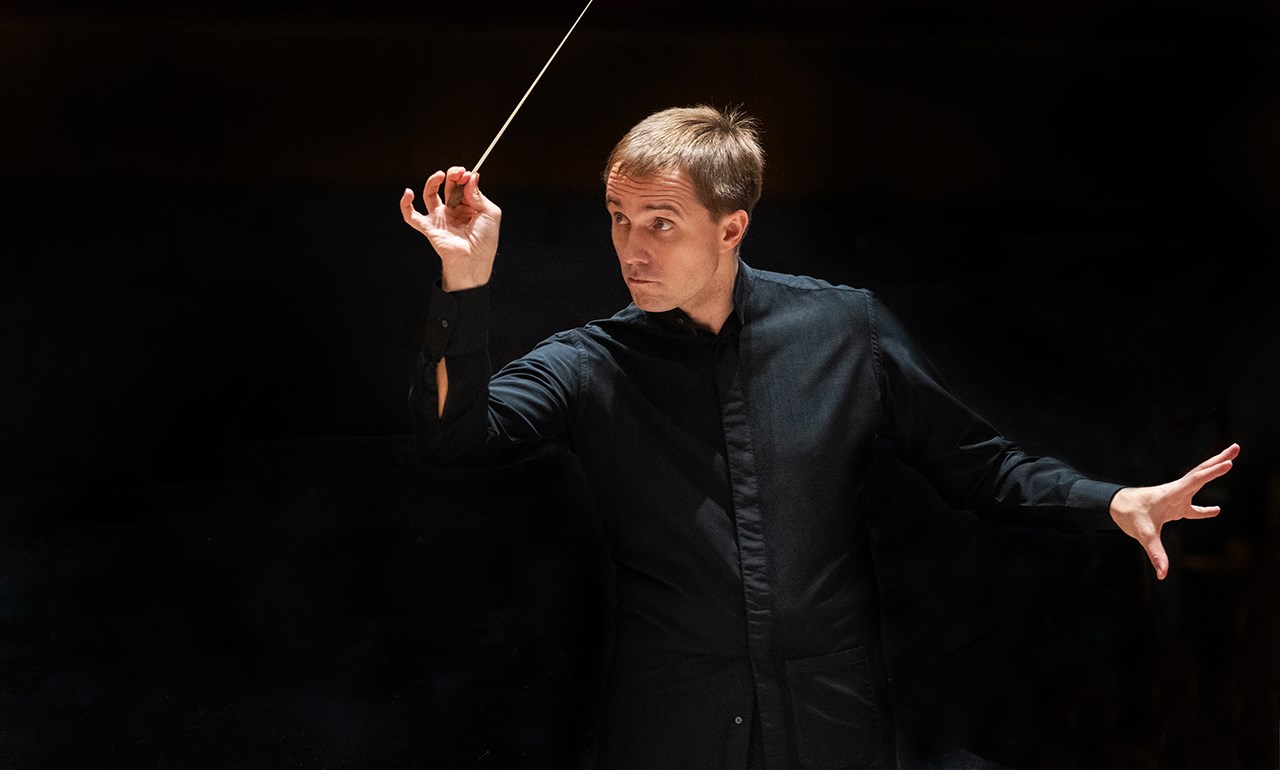
Mixing up versions
Although the original version of Boris Godunov was never performed during Mussorgsky’s lifetime, the existence of two versions of the opera offers the possibility of creating composite variants that combine music from both versions. But cuts can also be made. “I think it would be interesting to do a complete version with all the available music, but that would result in a very long opera indeed. In Amsterdam we basically follow the revised version, with some small cuts here and there. Conductors have made cuts throughout the performance history of the opera. However, we have also revived the scene at the Cathedral of Vasily the Blessed, which is normally only in the original version. That’s because it’s easier to follow the story with this scene included than when it is omitted.”
Including the Cathedral scene does mean the character of the Holy Fool now appears twice to sing his lament for the fate of Russia. “He is probably the only truly innocent character in the entire opera. Everybody else have something a bit dark, either in their background or through their participation in the events unfolding. In a way the Holy Fool represents the truth, and if that truth is more prominent on stage in this way, it creates a different perception.”
An opera about the people
The music included from Mussorgsky’s original version also adds more material for the chorus to sing. “Boris Godunov is very much an opera about the people, about the crowd, and the more they can be on stage, the more they can become the true protagonists. Mussorgsky didn’t want the opera to finish with Boris’ death. The scene in Kromy forest was already in his mind as the conclusion to the opera; this historical narrative and framework were very important to him. But he was either not brave enough, or did not feel free enough, to end the opera like that originally. However, the Kromy scene gives the opera a beautiful symmetry and cyclical feeling: it begins with the people and it ends with them.”
Artistic team
Cast
Always know what’s on
Be the first to be informed about our productions and receive exclusive content in your inbox.
Success!
From now on you will receive our performance updates.
Something went wrong
Something went wrong, please try again later. Apologies for the inconvenience.


